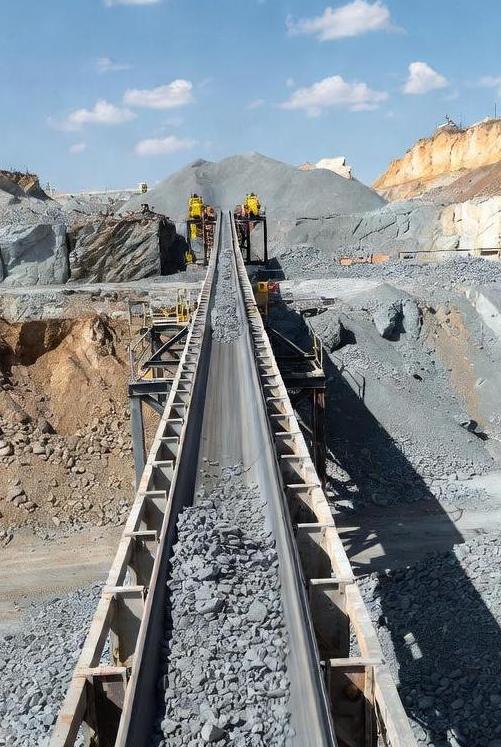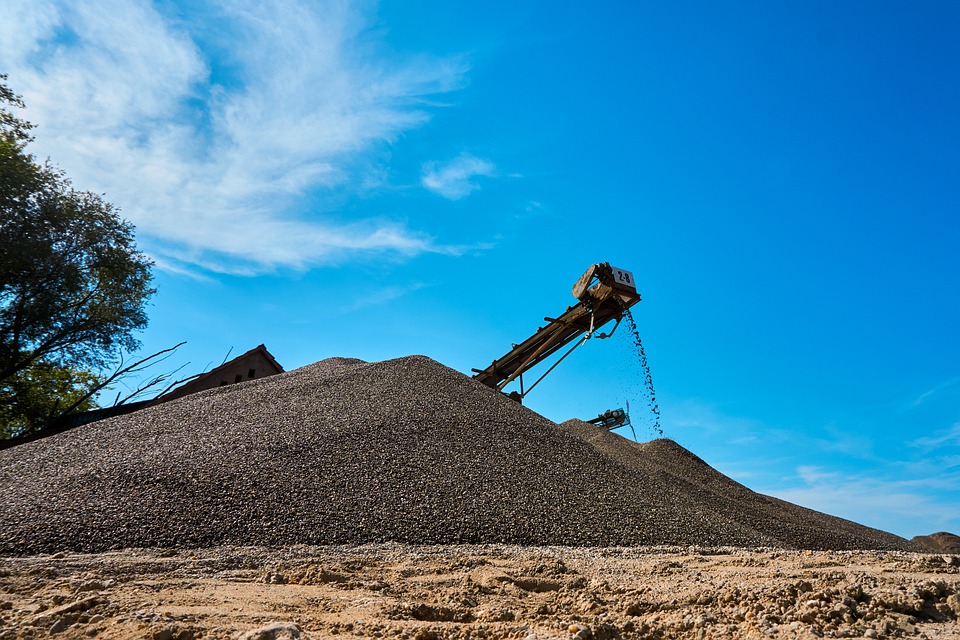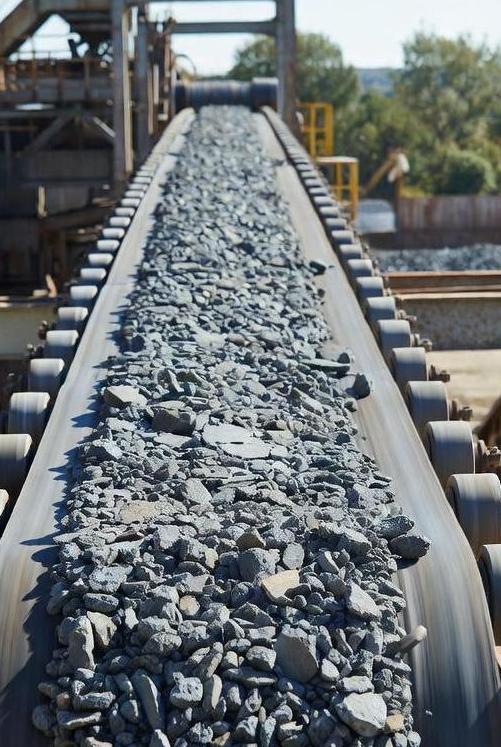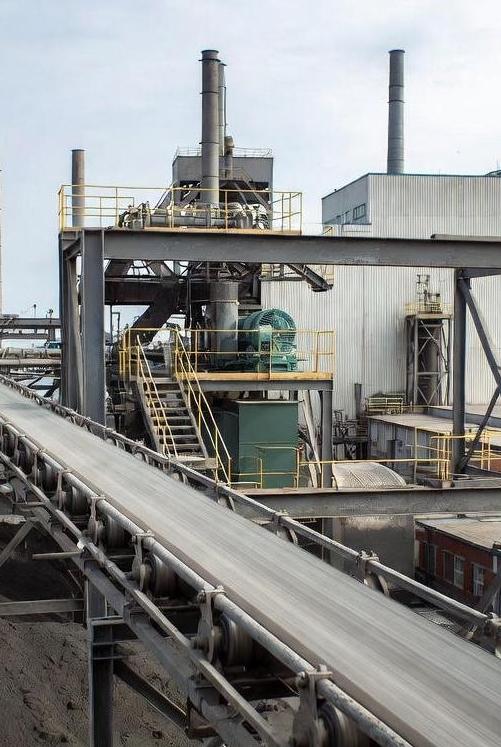
The Ultimate Guide to Material Handling Belt Conveyors in Mining, Aggregates, Quarries & Cement Plants
In modern bulk material handling, belt conveyors remain the backbone of high-volume, long-distance, and heavy-duty transportation. Whether you are moving 3,000 t/h of iron ore in an open-pit mine, transporting 1,500 t/h of limestone from a quarry face, handling hot clinker at 500 °C in a cement plant, or feeding a secondary crusher with recycled concrete aggregates, the correct belt conveyor design directly impacts uptime, energy consumption, safety, and total cost of ownership.

This comprehensive technical guide covers everything engineers, plant managers, and procurement teams need to know in 2025.
1. Why Belt Conveyors Dominate Heavy Industry
Highest throughput-to-cost ratio for distances 50 m – 20+ km
Continuous operation 8,760 h/year possible with proper maintenance
Ability to handle abrasive, hot (up to 600 °C with special belts), sticky, or dusty materials
Lower energy consumption than truck haulage (typically 0.08–0.15 kWh/t·km vs. 0.5–1.2 kWh/t·km for diesel trucks)
Reduced dust and noise emissions → better ESG compliance
2. Key Applications & Specific Requirements

2.1 Mining Belt Conveyors (Coal, Iron Ore, Copper, Gold, Bauxite)
Belt widths: 1,200–2,600 mm
Capacity: 2,000–15,000 t/h
Typical features: high tensile steel-cord belts (ST1000–ST7000), fire-resistant & anti-static (FRAS) covers, impact beds, self-aligning idlers, ATEX-rated components for underground coal
Longest single-flight systems: >15 km (e.g., Los Pelambres, Chile – 12.7 km, 12,700 t/h)
2.2 Aggregate & Quarry Belt Conveyors
Belt widths: 600–1,600 mm
Capacity: 300–2,500 t/h
Critical zones: loading point (rock box + ceramic-lined impact idlers), skirtboard sealing, dust suppression
Common belt types: EP400/3–EP1000/4 with 8–15 mm abrasion-resistant covers (DIN-Y, DIN-X)
2.3 Cement Plant Belt Conveyors
Raw material feed (limestone, clay, shale)
High-incline conveying (up to 18° with chevron belts)
Hot clinker handling (400–550 °C) → heat-resistant belts (T120–T250) with special rubber compounds
Overland lines from quarry to plant (often 3–15 km)
Air-supported belts gaining popularity for reduced idler maintenance and dust
3. Modern Belt Conveyor Design Standards (2025)
| Component | Latest Design Trend (2025) | Benefit |
|---|---|---|
| Idlers | Sealed-for-life, polymer shells, low-noise (CEMA E–F) | 50% less rotating resistance |
| Belting | Energy-optimized low-rolling-resistant (LRR) compounds | 10–20% power savings |
| Drive systems | Permanent-magnet synchronous motors + medium-voltage VFDs | Efficiency >98%, regenerative braking |
| Take-up | Automatic winch + gravity tower hybrid | Constant tension, reduced belt stress |
| Monitoring | IoT sensors (belt wear, rip detection, temperature, misalignment) | Predictive maintenance → 99.9% availability |
4. Critical Design Parameters You Must Calculate
Capacity (t/h) = Belt speed (m/s) × 3600 × Material cross-sectional area (m²) × Bulk density (t/m³)
Belt width selection (ISO 5048 / CEMA 7th)
Power requirement = (Horizontal + Lift + Tripping) resistance × safety factor
Idler spacing: 0.8–1.2 m (carrying), 2.5–3.5 m (return) for heavy mining
Transition distance to prevent spillage & belt damage
Concave/convex curve radius (minimum 500 × belt width for steel cord)
5. Common Failure Modes & 2025 Solutions
| Failure | Root Cause | Modern Solution |
|---|---|---|
| Belt rip | Tramp metal, impact | Multi-point rip detection + ceramic-embedded covers |
| Carryback | Poor scraper design | Primary + secondary polyurethane + air-blade systems |
| Idler seizure | Dust ingress | Labyrinth + contact seals, polymer rolls |
| Mis-tracking | Uneven loading | Self-training idlers + automatic centering rollers |
| Spillage | Poor skirt sealing | Clamp-style adjustable skirts + ceramic liners |
6. Sustainability & Energy-Saving Trends in 2025
LRR (Low Rolling Resistance) rubber → 15% average energy reduction
Air-supported conveyors → 70% fewer idlers, 30% less power
Regenerative downhill conveyors feeding power back to the grid
Use of recycled steel cord and rubber in belt manufacturing
Digital twins for route optimization and load scheduling
7. Conclusion: Choosing the Right Belt Conveyor System in 2025
A modern material handling belt conveyor is no longer just a steel structure with a rubber belt — it is a sophisticated energy-efficient, predictive-maintenance-enabled system that directly impacts your mine or plant profitability.
When planning your next project, focus on:
Life-cycle cost (not just initial price)
Energy consumption per tonne-kilometer
Digital readiness (IoT, condition monitoring)
Local service and genuine OEM spare parts availability
Need a custom belt conveyor calculation, route layout, or CAPEX/OPEX comparison between truck vs. conveyor? Contact our engineering team for a free preliminary design study.
 The Ultimate Guide to Material Handling Belt Conveyors in Mining, Aggregates, Quarries & Cement Plants
The Ultimate Guide to Material Handling Belt Conveyors in Mining, Aggregates, Quarries & Cement Plants
 Tubular Belt Conveyor: Revolutionizing Bulk Material Handling
Tubular Belt Conveyor: Revolutionizing Bulk Material Handling
 Understanding the Cost of Conveyor Belts: A Comprehensive Guide for Businesses
Understanding the Cost of Conveyor Belts: A Comprehensive Guide for Businesses
 How to Choose the Best Mining Conveyor Idlers for Your Operation
How to Choose the Best Mining Conveyor Idlers for Your Operation
 Daily Idler Maintenance Checklist: A Comprehensive Guide
Daily Idler Maintenance Checklist: A Comprehensive Guide
 How to Choose the Right Belt Conveyor Company: A 2025 Buyer’s Guide
How to Choose the Right Belt Conveyor Company: A 2025 Buyer’s Guide
 Conveyor Idlers Installation Guide: From Beginner to Expert
Conveyor Idlers Installation Guide: From Beginner to Expert
 Customised conveyor idlers size to meet diversified needs
Customised conveyor idlers size to meet diversified needs




